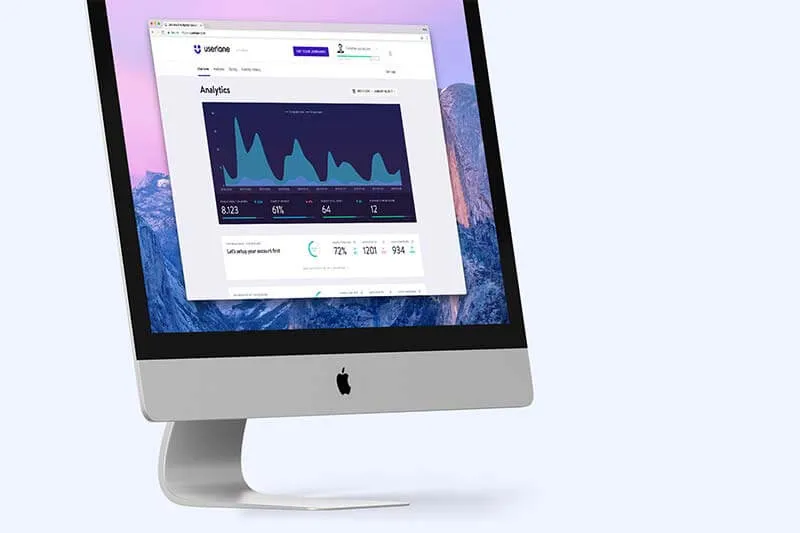Improve User Onboarding and Customer Experience

It’s not a secret that the key to a successful user onboarding strategy is data. All the information you can collect about people who like your product and want to go for a trial represents precious input for marketing and sales, while data about engagement and usability is the basis for product management decisions.
Every piece of information we can gather about the potential misunderstandings or struggles people go through when testing your application, allows you to redefine and optimize the interface and processes within the product or the simply streamline the onboarding experience in order to offer a smooth user experience.
A few days ago, I had the honor and pleasure to chat with Nikbin Rohany, founder and CEO of absence.io. I purposefully used the word ‘pleasure’ because not only is Nikbin a successful entrepreneur, but he’s also extremely likable and a very easy-going person to have a conversation with.

Absence is a very clever tool that allows employees to manage their own vacancies. The application, recently acquired by Shore, streamlines HR logging and reporting activities connected to different sorts of vacancies, from vacation days to sick or parental leaves.
During my talk with Nikbin, I tried to understand what elements within the overall UX contribute to successful onboarding operations and what specific factors absence focused on when looking at analytics.
Before digging in, and discuss some of the interesting insights that came up during our chat, let’s quickly see what tools and tactics SaaS product managers and UX designers can leverage in order to analyze onboarding data and optimize the process for increasing conversion and engagement rates from the very beginning.
Table of Contents
The Importance of Metrics for Evaluating User Onboarding
As underlined by Nikbin during our conversation, tracking conversions is obviously an essential step when it comes to evaluating how efficient you user onboarding strategy is.
The key value, in this case, is simply the proportion of trials that turn into paid customers. This simple metric is essential to assess the overall user experience and targeting.
But there also are other important indicators, and breaking down the process allows SaaS owners and product managers to improve communication and the customer experience.

The main goal is designing an effective free trial flow that allows users to go from zero to hero in the shortest time. The onboarding experience will in fact set the mood for the relationship between user and product and heavily influence conversion and churn.
That’s why being able to collect precious information during this initial phase in order to optimize the whole user onboarding experience will have a positive impact on conversion and retention rates.
The Metrics that Define the Customer Journey
Absence, as basically any other SaaS company, uses standard traffic analytics to monitor their basic marketing efforts.
The first portion of the standard funnel many businesses initially work with go from website visitors to free trials. This is an obvious indicator that proves the effectiveness of targeting and the conversion rate of the website in general or the specific product pages traffic is directed to.
The important thing then, is finding all the common characteristics presented by users who go from trial to becoming paying customers.
The more information we can collect during the onboarding phase, the easier it is to spot all the properties that are specific to potential customers. This data, in turn, can feed marketing acquisition and sales processes.

Knowing these characteristics eliminates most of the guesswork which is connected to your customer persona.
As Nikbin pointed out, you can adjust and tailor the entire user experience for a very specific target group that you know will actually engage with and benefit from your product.
The very first step in the process, is implementing tests, personalization, triggers, and collect data during the user onboarding process.
Luckily, nowadays, there’s no lack of apps that can be integrated and that specifically serve the purpose of analyzing and improving the customer experience!
Tools like MOZ, Intercom, Totango, Mixpanel, Segment, Userlane, KISSMetrics, Hubspot or Salesforce are invincible instruments that capture key data about the behavior of visitors, users, and customers that go hand in hand with survey tools and helpdesk solutions such as Qeryz and Zendesk.
The difficult step, though, is knowing what to do with all the data and particularly:
- Identify significant correlations
- Define those characteristics which are closely related to the target group
- Tailor and optimize the customer journey for a very specific group of users who have proven to be linked to customer success
User Onboarding as most Important Element of the Funnel
Once you lead the right traffic to your site and optimize your product pages to direct the right target group to sign up for a trial, the most important step which will define the success of your user experience is the onboarding process.
Optimizing each step of the processes requires you to collect detailed information that can be used to eliminate confusion in both the UI and in the process path of your application.
Driving traffic to your website is expensive and time-consuming. What you really can’t afford is seeing users leak during their trial because they can’t see the benefits of your solution or because they can’t successfully accomplish tasks in your application once they get stuck.
A significant user onboarding experience should lead to engagement and immediate activation. In order to succeed, it is necessary to define all those elements which are important to customers and organically lead users through the discovery of such features.

As pointed out by Nikbin during our chat, traffic analytics and signup rate only represent the tip of the iceberg. Customer success starts with activation.
One of the key metrics at this stage is engagement rate. Evaluating the number of trial signups that actually interact with the product right away is essential to define how easy it is to go from requesting a free trial to actually engaging with the product.
Additionally though, it is necessary to collect data regarding activation. Knowing how many first time trial users return back and interact with your product after interacting with it is an important signal.
This data is important to assess both the onboarding process itself and the efficacy of habit formation tactics such as emails, push notifications, reminders, offers…
The whole discovery journey needs to be smooth and the user must be reminded of why they signed up for a trial in the first place. Then, it’s just a matter of supporting each user and making sure that they see immediate results.
There are multiple challenges that businesses need to face when designing a successful user onboarding process, says Nikbin. Crafting the experience to meet customer’s expectations is also partially connected to making sure that the target group is selected accurately. Additionally, though, allowing for exploration while also guiding users and making sure that the product is clear in a fast and efficient way leads to several decisions that can make or break the experience.
How analytics can be used to influence the Customer Experience at different Stages of the Customer Journey
Traffic and tracking analytics evaluate the validity of marketing efforts and can be used to optimize the customer persona, targeting, marketing channels, copy and on-site conversion rate.
A low percentage of free trial requests, can signify either a poorly performing product page that lacks essential conversion elements or a low quality in terms of traffic which can in turn derive from wrong assumptions regarding the customer persona or wrong targeting.
Tracking engagement and activation is essential to adjust the signup processes and user onboarding. Users who don’t even engage with the product or never return back after using it once indicate either a wrong target group (enticed by inexact promises or promotional messages) or a confusing onboarding process that doesn’t effortlessly guide users through all the essential steps and features that lead to success.

Absence leads its users by the hand with a full onboarding tour created with Userlane that works both as a checklist (to make sure that people go through all the steps in the correct order to optimally set up the ecosystem) and as a virtual assistant that presents core features and benefits.
Additionally, by inspecting onboarding analytics collected through Userlane, absence can identify those steps which generate perplexity and that could potentially lead users to exit the platform.
These analytics reveal completion and engagement at each step of the onboarding process and offer the best breakdown metrics that can be used to collect granular data regarding the behavior of users within the UI and their interaction with specific processes.
Learn more about employee training and support
By identifying potentially confusing steps, absence managed to optimize the UI and UX within their product and make sure that users are steered through the product in a seamless and pleasant way.
Alignment with Support and Customer Success
Another set of metrics that can be analyzed to optimized user onboarding is the data that SaaS companies can derive from support and customer success.
The number of incoming requests and the kind of issues reported by first-time users are strong indicators of problematic areas within the product.
Customer support comes in two flavors: proactive and reactive. All the measures we put in place, from walkthroughs to a personal assistant, documentation or tutorials need to be optimized with data collected through helpdesk requests.
Such requests offer important analytics that can be used to either re-evaluate UI elements and processes or improve guidance and support during the user onboarding phase.

A successful strategy, according to Nikbin, is represented by decision-making processes which involve the entire UX. In essence, trying to find a balance between additional features and usability.
Customer requests and onboarding data might point to specific modifications that would have a negative impact on usability or shift the focus of the product from the original concept. Finding the sweet-spot, in this case, is key to customer success.
That’s why it’s vital that product managers, customer success managers, support, engineers and UI/UX designers all work together and share data. Analytics collected at different stages of the customer journey can be used by every unit even if not directly involved at that step.

Optimizing presentation, targeting and user onboarding has a significant impact on sales and retention, together with apt pricing tests and product management.
In order to boost conversions and MRR companies not only need to collect the right analytics at the right stage, but they also need to have a precise plan of action that derives from the collaboration of different units in order to optimize the entire customer journey.
Absence’s Roadmap to Success
For absence, everything starts with bringing the right target group closer to the product and allowing them to explore their application without any barriers or gates.
With Userlane, absence can then lead users through the discovery of their product while presenting key features and explaining advantages. The onboarding data collected through Userlane together with customer surveys and support data help them optimize the interface and the user experience.
Conversion rate is important, but the overall concepts of customer success and satisfaction are pivotal aspects of product management. Absence focuses on the entire customer journey and planned the whole UI according to a well-defined idea of customer experience they designed from the very beginning.
“Everything starts with a good product” mentioned Nikbin. Usability and UX are intrinsic characteristic of the product while onboarding metrics can be used to design the customer experience.
Nikbin relies on analytics to mainly improve the discovery journey and, in some rare occasions, also to carry out small adjustments in the product itself. Tuning the user onboarding experience has proven to have a tremendous impact on conversion, activation, and retention.
The key takeaway from my conversation with Nikbin then is that nothing can beat a well-designed product, while a great user onboarding experience supported by guidance and analytics guarantee a smooth customer experience. Eventually, though, the key element of a successful SaaS product is the overall customer satisfaction.
Learn more about employee training and support

